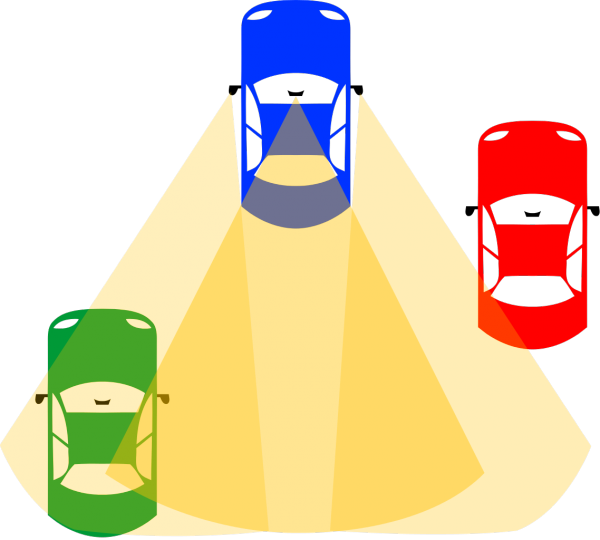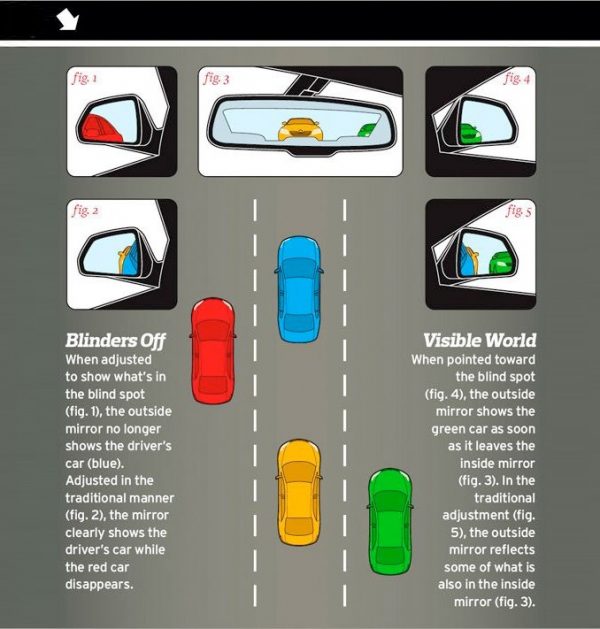The sticker warning that “objects in mirror are closer than they appear” is only useful when you can actually see other vehicles behind you. If you can’t, you may have aligned your side-view mirrors incorrectly and could be at a higher risk for collisions (hundreds of thousands of auto crashes annually are attributed to blind spots). It is a common mistake and easy to make but fortunately just as simple to rectify. The Society of Automotive Engineers (SAE) published a paper years ago coming to this same conclusion and advocating an alternative approach.
First, though: setting the inside (middle) mirror properly is a straightforward task — its should be centered to your view (positioned so you can see across your rear windshield while driving). This seems obvious, but it foreshadows an issue in setting side-view mirrors.

Side mirrors leave room for interpretation — there is no center point to guide their placement. Many people feel inclined to tilt them too far inward, allowing drivers to see the side of their own vehicle but exacerbating blind spots in the process. This overcompensation is entirely unnecessary and creates overlap between mirrors — a slightly different arrangement leads to more seamless rear-view panorama.
The following simple method to align your mirrors in a more optimal way involves shifting your head in order to view each mirror from a specific position during the setup process (as demonstrated above). For the passenger-side mirror (on the right for those in the United States): move your head over to the center of the vehicle and adjust the mirror so that side of your vehicle is just barely in view. Then, for the driver’s side: move your head so it is directly next to the window and adjust the mirror so that side of your vehicle is barely visible from that position. When you move back to your your normal seated position, the sides of your own car should be just barely out of view.

Like any customizable design allowing adjustment, proper execution is a combined effort of a designer and end user. The real key (for the driver) is getting over the notion that you need to see your own car in your side view mirrors. You know what your car looks like and where it is — there is no need to have it for reference in a reflection. Instead, you should aim to reduce overlap between central and side mirror range, capturing as wide of a view as possible between them.
Cars behind you should now appear to move cleanly from one mirror to the next. Meanwhile, your peripheral vision has less potential missing ground to make up — cars will move seamlessly between rearview and side mirrors, then shift into your peripheral field of view. Depending on the car, this approach can help reduce or even eliminate blind spots, letting drivers more safely see vehicles on all sides.
Bonus: Winter Trick to Defrost a Windshield
Clearing frost from your windshield in winter by warming up the car and using the defrost function takes time. Using a scraper can be a pain and leaves you standing out in the cold. Some people even splash warm or hot water to speed things up — a dangerous play that can break a windshield or simply refreeze in sub-freezing weather.
A simple solution of household materials can help get the job done faster and more easily: it consists of one part water and two parts isopropyl (rubbing) alcohol. The alcohol is the key: it has a freezing point of negative 128 degrees. Mix the two in a spray bottle and keep it handy — you can even leave it in the car in sub-zero temperatures.



Comments (21)
Share
I think the impulse to keep a little bit of your car visible in the mirror is so that you have a better sense of relative depth – after all, the mirror being further away from you is why the objects appear further away in the first place.
Objects look farther away because the passenger wing mirror is convex. The driver’s side wing mirror is flat.
It is true that keeping your car visible when driving is useless. But when manouvering, parking for instance, having your own car in the mirror as a reference is very useful. There are less risks involved though, so I think it might be a good trade.
The adjustment proposed here makes the mirrors great for highway driving but useless for parallel parking. It’s helpful to be able to see the rear corner of your vehicle and the front corner of the one behind you. Your inside mirror can’t show you those.
While that’s a valid and commonly stated argument, you have to consider where your head is positioned, and vision is directed, in the two scenarios.
While parking, you are free to rotate your body/move your head around to get a good viewing angle.
While driving, your head is usually static and shifting your head around to adjust your angle to the side mirrors is less safe than having the mirrors positioned to reduce that motion.
Ultimately, it truly does come down to preference, but we all should be open to trying out better ways to do things.
Depending on the state you live in I would not recommend leaving a bottle of isopropyl alcohol in your car. It could be misidentified by a cop as liquor, and having an unsealed bottle of alcohol in your car is illegal in some states. It would be safest to leave it in the trunk. At the very least it could avoid a confusing situation.
This advice is, as it always has been, idiotic. I don’t care if it’s better at seeing the blind spot twisted your way; if I don’t have the edge of my own car for reference the entire mirror is a blind spot.
The image in the mirror is only useful insofar as it helps the driver know the state of their surroundings. Without a clear point of reference, it can’t do that at all.
You’re overcomplicating this. The purpose of the mirror is provide information on whether they can safely change lanes. If you see a car in your wing mirror, it’s not safe. Why do you need your own car as a reference?
Yeah, I’ve done this for years (heard it on Car Talk as mentioned below). You don’t need the reference it just takes a little bit of getting used to; you have to break the habits that you developed to deal with the fact that you had a much bigger blind spot. Once you get used to it, you realize that you don’t need to glance behind you to safely merge, you’re blind spot is pretty much reduced to something a slight turn of your head will cover.
The biggest shortcoming of this method is the situation where you need to move to the right hand lane and something is blocking your view of that lane to your rear. (Think parallel parked on the left side of the the street and a delivery truck parks right behind you behind you). In that case you basically have to adjust the mirror back to where you’re used to or you’ll be merging blind. For that reason I don’t think I’d use this in a car without power mirrors.
”Some people even splash warm or hot water to speed things up — a dangerous play that can break a windshield ” I doubt that.
Thermal shock. While unlikely to do damage to an unblemished windshield, cracks (even invisible ones) can be forced to expand due to the shock.
The mirror technique is interesting and probably helpful but you still need to being doing head checks for every lane change maneuver. Motorcycles and bicycles could be in those spots not quite covered.
Car Talk also covered this years ago, but the method was slightly different. Instead of leaning over and putting your head in the center of the car or over by your window, just turn your head all the way to the right to adjust the right mirror, or all the way left to adjust the left mirror. It gives you the same result, and cars behind you seamlessly transition from one mirror to the other.
This link from Car Talk describes in detail how to adjust your mirrors.
http://www.cartalk.com/sites/default/files/features/mirrors/CarTalkMirrors.pdf
Thank you for pointing this out. Every time I go my dealer’s garage, they re-set the mirrors so that I can only see the side of the car. Which is useless in traffic. But there is an easier method. Just set your center mirror. Then, while parked of course, take note of the items you can see at the very edges of the center mirror. Now, re-set the side mirrors without moving your head so that the inside of the respective side mirror just slightly overlaps with the items at the edges of the center mirror. Perfect.
Now, for parallel parking, you don’t need mirrors. Pull up even with the car in front of the space you want. Then reverse slowly. When your passenger side rear door window is even with the rear end of theparked car next to you, cut the wheel to the right.
Keep reversing. When looking out your rear window and your outside rear driver’s side looks even with the front passenger side headlight of the car behind you, cut the wheel hard left. You will slide into the parallel parking spot perfectly.
I have read as many stories saying that using alcohol for de-icing is bad for your car especially your blades.
I use a bottle of wiper fluid. It never freezes and is designed to be on a wind shield.
Know why washer fluid doesn’t freeze? Alcohol.
I have been doing this as long as I have been driving–when i was in driver’s Ed, my dad took a defensive driving class for a discount on his car insurance and they told him to put his mirrors like this. my driver’s ed teacher would always bitch at me for changing the mirrors so much but i told him this is how you don’t have a blindspot.
all the people complaining about how you can’t parallel park with your mirrors like this–i live in the city and parallel park every day, never had an issue, in fact, I usually can get in 1 back up. you don’t need to see the side of your own car to park!
Thanks for sharing this information with us regarding cars mirror. I really found this very helpful. And Your blog also very interesting.
Thank you for sharing this information, I used to be confused when adjusting the rearview mirror blind spot. It’s great to read the information in your post.
I worry that setting them this way, without a hint of your own back corner, will give you a false sense of security about your back corners. Sure, a car can’t fit in the gap between the mirrors, but a pedestrian, bike, or scooter could. As a cyclist, I’ll probably often disappear between your mirrors if I’m in the bike lane to your right, and perhaps even if I’m riding in one of the wheel ruts to avoid debris. This seems like a good way to have drivers cut off or hit cyclists who are just behind them in the bike lane when turning the car right, although I’m not sure that any mirror placement really mitigates that common accident scenario much.
Just another remind that bicycles safety is a poorly-understood second thought in most things traffic and automative. Make sure that you are seen, for instance by riding in the center of the lane rather than hanging right, or even using the bike lane.